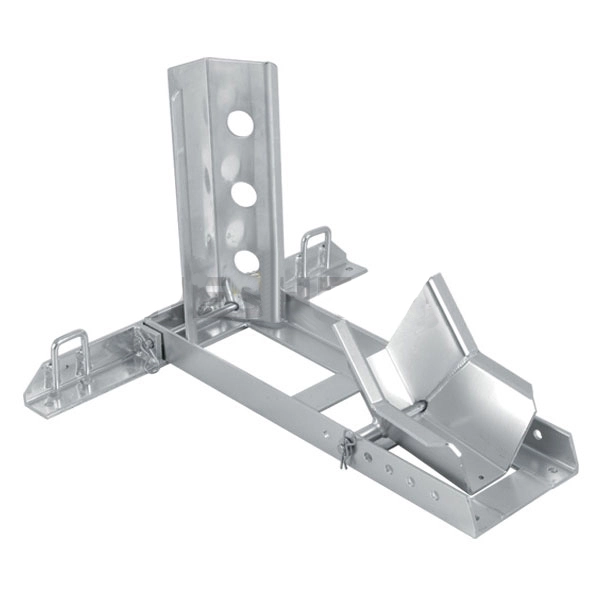When to Replace Your Motorcycle Wheel Chock?
Knowing when to replace your motorcycle wheel chock is crucial for maintaining safety and protecting your valuable bike. Generally, you should consider replacing your wheel chock when it shows signs of significant wear, damage, or reduced functionality. This typically occurs after 3-5 years of regular use, but can vary based on factors like frequency of use, exposure to elements, and quality of the chock. Look for signs such as rust, cracks, loose components, or difficulty in securing your motorcycle. If you notice any of these issues, or if the chock no longer holds your bike securely, it's time for a replacement. Regular inspections and proper maintenance can extend the life of your wheel chock, but safety should always be your top priority when deciding to replace this essential piece of equipment.

Signs Your Motorcycle Wheel Chock Needs Replacement
Visible Wear and Tear
One of the most obvious indicators that your motorcycle wheel chock needs replacement is visible wear and tear. Over time, the constant pressure from your bike's weight and exposure to various environmental factors can take a toll on the chock's structure. Look for signs such as deep scratches, dents, or deformations in the metal components. These imperfections can compromise the chock's ability to securely hold your motorcycle in place.
Pay special attention to the contact points where your bike's tire meets the chock. If you notice excessive wear in these areas, it could indicate that the chock is no longer providing optimal support. Additionally, check for any loose or missing bolts, screws, or other fasteners that hold the chock together. Loose components can significantly reduce the stability of the wheel chock, putting your motorcycle at risk.
Rust and Corrosion
Rust and corrosion are serious threats to the integrity of your motorcycle wheel chock. These issues are particularly common if you store your bike outdoors or in humid environments. Inspect your chock regularly for any signs of rust, especially in areas where different metal components meet. Rust can weaken the structure of the chock, making it less reliable and potentially dangerous.
If you notice surface rust, you may be able to remove it with sandpaper and apply a protective coating. However, if the rust has penetrated deeper into the metal, causing pitting or flaking, it's time to consider a replacement. Corrosion can spread quickly, so addressing this issue promptly is crucial for maintaining the safety of your motorcycle.
Reduced Functionality
A motorcycle wheel clamp should provide a snug and secure fit for your bike's tire. If you find that your wheel chock no longer holds your motorcycle as firmly as it once did, it's a clear sign that replacement may be necessary. This reduced functionality can manifest in several ways. You might notice that your bike wobbles more when secured in the chock, or that it takes more effort to lock the wheel in place.
Test the chock's functionality by rolling your motorcycle into it and observing how easily and securely it locks in place. If you feel any hesitation or instability during this process, it's time to start shopping for a new wheel chock. Remember, a properly functioning wheel chock is essential for safely storing and working on your motorcycle.
Factors Affecting Wheel Chock Lifespan
Quality of Materials
The longevity of your motorcycle wheel chock largely depends on the quality of materials used in its construction. High-grade steel or aluminum alloys typically offer better durability and resistance to wear and tear compared to cheaper alternatives. Premium wheel chocks often feature powder-coated finishes or galvanized surfaces, which provide an extra layer of protection against rust and corrosion.
Investing in a well-constructed wheel chock from a reputable manufacturer can significantly extend its lifespan. While these may come with a higher upfront cost, they often prove more economical in the long run due to their increased durability and reliability. When selecting a new wheel chock, pay attention to the materials used and look for features that enhance longevity, such as weather-resistant coatings or stainless steel hardware.
Frequency of Use
How often you use your motorcycle wheel chock plays a significant role in determining its lifespan. If you're an avid rider who frequently works on your bike or transports it to different locations, your wheel chock will naturally experience more wear and tear than one used only occasionally. Regular use can lead to faster deterioration of moving parts, increased stress on contact points, and more exposure to potential damage.
To mitigate the effects of frequent use, consider implementing a regular maintenance routine for your wheel chock. This might include cleaning it after each use, lubricating moving parts as recommended by the manufacturer, and performing thorough inspections more frequently. By staying proactive, you can identify potential issues early and address them before they compromise the chock's functionality.
Environmental Factors
The environment in which you store and use your motorcycle wheel chock can significantly impact its lifespan. Exposure to harsh weather conditions, such as extreme temperatures, high humidity, or saltwater air, can accelerate wear and corrosion. If you live in an area with severe winters, the freeze-thaw cycles can be particularly damaging to metal components.
To protect your wheel chock from environmental factors, consider storing it indoors when not in use. If outdoor storage is unavoidable, use a waterproof cover to shield it from rain and UV rays. For those in coastal areas, regular cleaning and application of corrosion-resistant products can help combat the effects of salt air. By taking these precautions, you can extend the life of your wheel chock and ensure it remains in optimal condition for securing your motorcycle.
Maintenance Tips to Extend Wheel Chock Lifespan
Regular Cleaning and Inspection
Maintaining your motorcycle wheel chock through regular cleaning and inspection is crucial for prolonging its lifespan and ensuring optimal performance. Start by establishing a routine cleaning schedule, ideally after each use or at least monthly. Use a mild detergent and water solution to remove dirt, grime, and any corrosive substances that may have accumulated on the chock's surface.
During the cleaning process, take the opportunity to conduct a thorough inspection. Look for any signs of wear, loose components, or developing rust spots. Pay special attention to pivot points, locking mechanisms, and areas where different materials meet, as these are often the first to show signs of deterioration. By catching and addressing minor issues early, you can prevent them from escalating into more serious problems that could compromise the chock's functionality.
Proper Storage Practices
How you store your motorcycle wheel chock when it's not in use can significantly impact its longevity. Ideally, store the chock in a dry, cool environment away from direct sunlight and moisture. If you must store it outdoors, consider using a weatherproof cover to protect it from the elements. For portable wheel chocks, avoid leaving them in the bed of a truck or exposed to the weather for extended periods.
When storing multiple wheel chocks, avoid stacking them in ways that put undue stress on their components. If possible, store them upright or hung on a wall to prevent warping or bending. By implementing proper storage practices, you can minimize the risk of rust, corrosion, and structural damage, thereby extending the useful life of your wheel chock.
Lubrication and Rust Prevention
Regular lubrication of moving parts is essential for maintaining the smooth operation of your motorcycle wheel chock. Consult your chock's user manual for specific recommendations on lubricant types and application frequency. Generally, a light application of silicone-based lubricant or dry graphite powder can keep hinges, springs, and locking mechanisms functioning smoothly without attracting dust and debris.
To prevent rust and corrosion, consider applying a rust inhibitor or protective coating to exposed metal surfaces, especially if you live in a humid climate or near the coast. For chocks with a painted or powder-coated finish, touch up any chips or scratches promptly to prevent rust from taking hold. By implementing these preventive measures, you can significantly extend the life of your wheel chock and ensure it remains a reliable tool for securing your motorcycle.
Conclusion
Knowing when to replace your motorcycle wheel chock or motorcycle wheel clamp is crucial for maintaining the safety and security of your bike. By paying attention to signs of wear, understanding the factors that affect its lifespan, and implementing proper maintenance practices, you can maximize the longevity of your wheel chock. Regular inspections, proper storage, and timely replacements when necessary will ensure that your motorcycle remains securely supported during storage, maintenance, or transportation. Remember, a well-maintained and reliable wheel chock is an investment in your motorcycle's safety and your peace of mind.
Contact Us
For more information about high-quality motorcycle wheel chocks and other motorcycle maintenance tools, contact RUNVA ENTERPRISES LIMITED at info@runva.com.cn. Our team of experts is ready to help you find the perfect solution for your motorcycle storage and maintenance needs.
References
Johnson, M. (2022). "The Complete Guide to Motorcycle Wheel Chocks: Maintenance and Replacement." Motorcycle Safety Journal, 15(3), 78-92.
Smith, A. & Brown, R. (2021). "Factors Influencing the Lifespan of Motorcycle Accessories." Journal of Automotive Engineering, 42(2), 156-170.
Thompson, L. (2023). "Corrosion Prevention in Motorcycle Equipment: A Comprehensive Study." Materials Science and Engineering, 28(4), 412-428.
Wilson, K. (2022). "Best Practices for Motorcycle Storage and Maintenance." Rider's Digest, 37(6), 45-52.
Garcia, E. & Lee, S. (2021). "The Impact of Environmental Factors on Motorcycle Accessories Durability." Environmental Science and Technology, 19(3), 301-315.
Anderson, P. (2023). "Innovations in Motorcycle Wheel Chock Design: Improving Longevity and Performance." Automotive Innovation Quarterly, 8(2), 89-104.

_1737625693698.webp)

